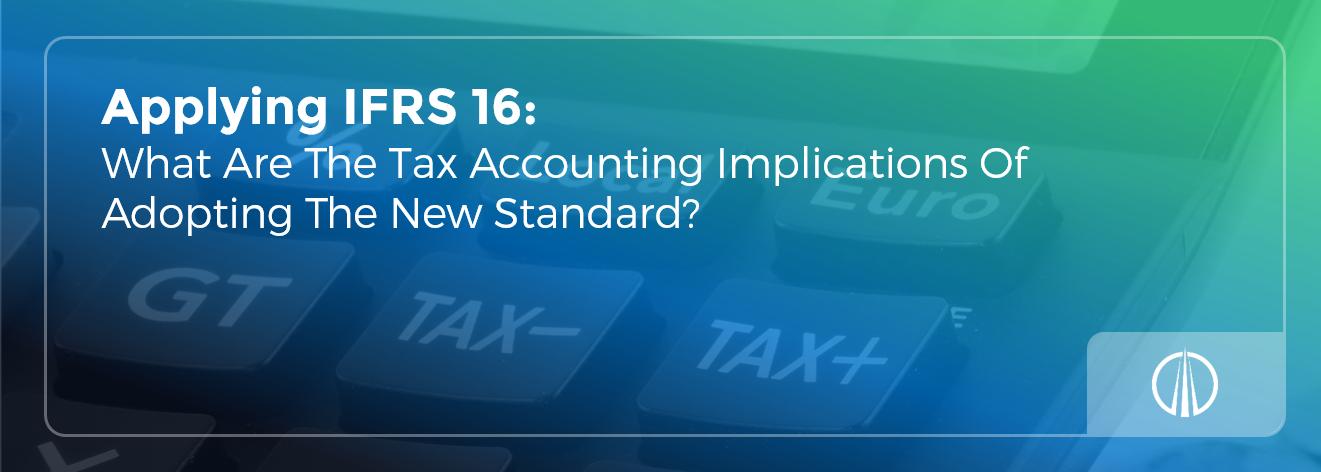Applying IFRS 16 – What are the tax accounting implications of adopting the new standard?
Updated 12th May 2021 | 7 min read Published 25th October 2018


1st January 2018 saw the deadline date for implementation of both IFRS 9 and IFRS 15 but for those charged with such compliance issues there is little respite with just 3 months (at the time of writing) to go to meet the regulations and standards set out in IFRS 16 which has a deadline date of 1st January 2019 and replaces IAS 17.
In this blog we will look at the tax accounting considerations and implications of the new standard.
Lessees will have a single accounting treatment for all leases
With limited exceptions all leases, whether finance or operating, will need to be reported on the balance sheet of the lessee who has, substantially, all of the economic benefits of the “use of the asset or assets” associated with the lease or leases. The main feature of the new standard is that rather than concentrating on the lease itself, which it does redefine, it recognises a lease only where it can identify an asset together with a “right to use” that asset. As stated above - who benefits from the right to direct the use of the asset must place the asset on their balance sheet together with any contingent liabilities whether rentals, dismantling costs or indeed installation costs. Reporting of such an asset will need to include where appropriate purchase options, residual guarantees, termination option penalties and any variable lease payments. The treatment of the lease of any asset as an expense will cease with just a couple of exceptions around low value and short period hire. This applies retrospectively to any leases still extant and of course to all leased assets going forward.
Under IAS 17 only finance leases needed to be capitalised on the balance sheet so consequent to the adoption of the new standard there will be affects to financial ratios, performance metrics and of course tax accounting calculations. With regard to tax then dependent on the jurisdiction the implications will vary but wherever a company is located performance measurements and gearing ratios will generally vary in a uniform manner to reflect the very reasoning behind the publishing of IFRS 16 – standard accounting of leased assets and associated liabilities whatever the rental, whatever the term and whatever the asset.
Performance Metrics and Gearing Ratios of Lessees will be affected by the adoption of IFRS 16 and the consequent accounting treatment of all leases
Whilst the treatment of leases, assets and liabilities for Lessors remains generally the same as prior to IFRS 16, in particular the performance ratios for lessees such as EBITDA, operating profit and net income will be affected. Dependent of which jurisdiction the lessee is reporting to the tax accounting will likewise vary. According to a worldwide survey on lease accounting under IFRS 16, conducted by one of the big 4 accountancy firms, in more than 70% of countries polled there is expected to be a deferred or current tax impact.
- With all but a couple of exceptions (see expedients below) the “right of use” assets subject to existing operating leases or any new leases will now be depreciated but more usually for tax purposes depreciation expense is not tax deductible.
- A similar impact on tax accounting in some countries may be felt due to debt to equity ratios being influenced by interest deduction limitations.
- Both of the above could have an adverse effect on the deferred tax position of dependent always on the tax jurisdiction, the length of the leases and treatment of the assets previously to adopting the new standard.
Lessees need to be aware of these points
-
- Any processes and controls relating to tax within an organisation may need redefining to ensure all relevant data is gathered at the start of the lease and where changes occur during the term of the lease – here an audit trail is key.
- The new standard may have an impact on any current tax agreements in place with the “Revenue” as a consequence of variation in lease and asset treatment by your company in particular.
- In certain tax jurisdictions, as already mentioned there will be interest deductibility concerns as gearing ratios, specifically debt to equity, are adversely affected.
- Transition to IFRS 16 and future compliance will likely result in changes to other ratios which in turn will impact KPI’s and possibly transfer pricing policy.
- Deferred tax assets will be proportionately impacted by the variance in the deferred tax position together with the differences in reversal pattern of book to tax.
Lessees need to be aware of the practical expedients available and impact on tax the use of some will carry
Accounting standards are continually being reviewed, clarified and replaced and the approach to the introduction and deployment of such new standards has resulted in increased consistency with the application of each. More recently the advent of new standards saw this in the “Conceptual Framework’s” requirement for costs imposed and recognised on preparers, regarding time and effort, having to be reflected in the benefits to users. This is evidenced in IFRS 15 by the ability to bundle similar service contracts into a single portfolio assuming that this would not result in any material misrepresentation or distortion of the financials relating to the contracts.
A similar approach is seen in the deployment of IFRS 16 and the practical expedients available under the standard. There are two ways of transitioning to the new standard and these approaches are, generally, referred to as
- Fully Retrospective
- Modified Retrospective
Practical expedients are available especially when following the Modified Retrospective Approach and these listed below can be reviewed with more detail in our blog “What are the practical expedients available under IFRS 16”.
- Treatment of Initial Direct Costs –
- Leases Expiring within 12 months of IFRS 16 Adoption –
- Discount Rate Application –
- Separating Out Non-Lease Components –
- Application of Hindsight –
- Expedients beyond Transition –
As you progress through transition and begin full scale adoption of IFRS 16 other expedients may be brought to your attention by the IASB, your auditors or indeed a blog similar to this but the 6 listed above if applied where sensible or necessary will result in a smoother, less taxing, less resource gobbling implementation of the new lease accounting standard for your business and the associated people.
With the above in mind under IFRS 16:BC128, the lessee must take into account any periods that are likely to be non-cancellable under either termination options or extension options. Under IFRS 16:18 the lessee will include any such non-cancellable periods as part of the lease term calculation.
HMRC Guidelines for Lessees Reporting in the UK
HMRC issued a consultation on the legislative changes required to ensure that the tax treatment of leases reflects the lease accounting rules upon the implementation of IFRS 16.
The focus of the consultation, which followed an earlier consultation in August 2016, is on the accountancy and tax interaction of leasing, particularly in relation to plant and machinery, but importantly for this blog it also considers the wider tax implications of IFRS 16.
Concurrently HMRC also issued a consultation on options for legislative changes required to ensure that the Corporate Interest Restriction Rules in Part 10 Taxation (International and Other Provisions) Act (‘TIOPA’) 2010 work as intended following the proposed repeal of section 53 Finance Act 2011 and the introduction of IFRS 16.
Both consultations ran until 28 February this year and responses to both were published on 11th July 2018
https://www.gov.uk/government/consultations/plant-and-machinery-lease-accounting-changes#history
Finally this blog wishes to remind all lessees that in this time of change where existing leases may be reclassified and future leases will need to have a record of any updates, extensions or adjustments then a portfolio system with full audit trail will be essential and LOIS Lease Accounting from Innervision is just such a process and system. Time is running out but adoption today and use of just such a system will allow you to accurately forecast and communicate the impact on tax, ratios and performance metrics to all interested parties – revenue, lenders, investors, managers and stakeholders.
These are just a few of the ways Innervision’s lease management software can help your business. To find out more about the benefits our tools offer our clients, contact us today. If you’d also like to know more about the upcoming IFRS 16 regulations, take a look at how IFRS 16 will impact your accounting business and Innervision’s “New Lease Definition” or 7 step guide to lease accounting compliance.
Disclaimer: this article contains general information about the new lease accounting standards only and should NOT be viewed in any way as professional advice or service. The Publisher will not be responsible for any losses or damages of any kind incurred by the reader whether directly or indirectly arising from the use of the information found within this article.





